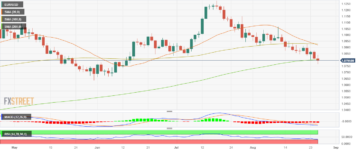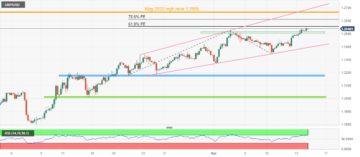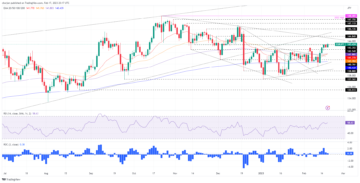
- NZD/USD kick-starts crucial week with mild losses, holds lower ground of late.
- Cautious mood ahead of Fed Chair Powell’s testimony, US jobs report and China inflation data weigh on Kiwi pair.
- China sets modest growth target during annual session of its National People’s Congress (NPC), eyes to overhaul major government departments.
- Risk catalysts, US Factory Orders to offer intraday directions.
NZD/USD retreats to 0.6210 after posting the first weekly gain in five as challenges to sentiment probe the Kiwi pair buyers early Monday. In doing so, the quote takes clues from the market’s cautious mood ahead of Federal Reserve (Fed) Chairman Jerome Powell’s half-yearly Testimony and the US employment report for February. Adding strength to the pullback moves could be the headlines from China’s annual session of the National People’s Congress (NPC).
As per the latest updates, China NPC eyes a modest growth of 5.0%, versus market expectations of 6.0%, for the current year. Apart from the softer Gross Domestic Product (GDP) expectations, after reporting the slowest yearly GDP growth of 3.0% in decades, geopolitical concerns were also discussed and weighed on the sentiment, as well as the NZD/USD prices. “China should promote the peaceful development of cross-Strait relations and advance the process of China’s “peaceful reunification”, but also take resolute steps to oppose Taiwan independence,” said outgoing China Premier Li Keqiang.
Elsewhere, recently downbeat US data and a retreat in the US Treasury bond yields from the multi-year high allowed the NZD/USD buyers to print the first weekly gains in five. That said, US ISM Services PMI for February came in as 55.1 versus 54.5 market expectations and 55.2 market forecasts. The inflation component of the PMI survey, the Price Paid sub-index, edged lower to 65.6 in February from 67.8 but surpassed analysts’ estimate of 64.5. The New Orders sub-index rose to 62.6 from 60.4 and the Employment Index advanced to 54 from 50 in the same period. Previously in that week, the US Durable Goods Orders for January eased while the Conference Board’s (CB) Consumer Confidence also flashed mostly downbeat details.
It should be noted, however, that the Federal Reserve (Fed) talks remained hawkish and tried to defend the US Dollar bulls, as well as propel the US Treasury bond yields. Over the weekend, San Francisco Federal Reserve Bank President Mary Daly said that if data on inflation and the labor market continues to come in hotter than expected, interest rates will need to go higher, and stay there longer, than Fed policymakers projected in December, as reported by Reuters.
Meanwhile, US Treasury bond yields initially refreshed the multi-month high before weighing on the US Dollar, as well as previously allowing the NZD/USD buyers to retake control. The reason could be linked to the unimpressive US data and the market’s receding fears of recession, mainly favored by headlines from China. That said, the US 10-year Treasury bond yields rose to the highest levels since November 2022 before easing to 3.95% at the latest while the two-year counterpart poked the July 2007 levels.
Amid these plays, Wall Street managed to close in the green zone but the S&P 500 Futures printed mild losses by the press time.
Looking ahead, NZD/USD traders should pay attention to Fed Chair Powell’s testimony and China inflation data, as well as updates from China NPC, for clear directions. Following that, the US jobs report for February could direct the Kiwi pair moves. Given the recently softer US data, the odds of witnessing a positive surprise for the pair buyers can’t be ruled out.
Technical analysis
Despite the latest pullback, the NZD/USD price remains firmer past 200-DMA support of 0.6165, which in turn keeps the buyers hopeful of crossing the immediate 100-DMA hurdle of 0.6230.
- SEO Powered Content & PR Distribution. Get Amplified Today.
- Platoblockchain. Web3 Metaverse Intelligence. Knowledge Amplified. Access Here.
- Source: https://www.fxstreet.com/news/nzd-usd-begins-the-key-week-on-a-back-foot-around-06200-focus-on-feds-powell-us-nfp-and-china-202303052324
- ][p
- 1
- 2022
- 67
- 8
- 95%
- a
- advance
- advanced
- After
- ahead
- Allowing
- Analysts
- and
- annual
- apart
- around
- AS
- At
- attention
- back
- BE
- before
- bond
- Bond yields
- Bulls
- buyers
- by
- catalysts
- cautious
- CB
- Chair
- chairman
- challenges
- China
- china inflation
- Chinas
- clear
- Close
- come
- component
- Concerns
- Conference
- confidence
- Congress
- consumer
- continues
- control
- could
- crucial
- Current
- data
- decades
- December
- departments
- details
- Development
- direct
- discussed
- doing
- Dollar
- Domestic
- during
- Early
- easing
- employment
- estimate
- expectations
- expected
- Eyes
- factory
- fears
- February
- Fed
- Fed Chair
- Federal
- federal reserve
- First
- Focus
- following
- Foot
- For
- Francisco
- from
- Futures
- Gain
- Gains
- GDP
- gdp growth
- geopolitical
- given
- Go
- goods
- Government
- Green
- Ground
- Growth
- Hawkish
- Headlines
- High
- higher
- highest
- holds
- However
- HTTPS
- immediate
- in
- independence
- index
- inflation
- initially
- interest
- Interest Rates
- ITS
- January
- Jobs
- jobs report
- jpg
- July
- Key
- labor
- labor market
- Late
- latest
- levels
- linked
- longer
- losses
- major
- managed
- Market
- Monday
- mood
- moves
- multi-year
- National
- Need
- New
- nfp
- noted
- November
- NZD/USD
- Odds
- of
- offer
- on
- orders
- Overhaul
- paid
- past
- Pay
- People
- period
- plato
- Plato Data Intelligence
- PlatoData
- pmi
- policymakers
- positive
- Powell
- Powell’s
- premier
- president
- press
- previously
- price
- Prices
- probe
- process
- projected
- promote
- Propel
- pullback
- Rates
- reason
- recently
- recession
- relations
- remained
- remains
- report
- Reported
- Reporting
- Reserve
- Reuters
- ROSE
- s
- S&P
- S&P 500
- Said
- same
- San
- San Francisco
- sentiment
- Services
- session
- Sets
- should
- since
- So
- stay
- Steps
- street
- strength
- support
- surpassed
- surprise
- Survey
- Taiwan
- Take
- takes
- Talks
- Target
- testimony
- that
- The
- These
- time
- to
- Traders
- treasury
- TURN
- Updates
- us
- US Dollar
- US Durable Goods
- US Durable Goods Orders
- US employment report
- US Factory Orders
- US ISM Services PMI
- US Jobs Report
- us NFP
- US Treasury
- Versus
- Wall Street
- week
- weekend
- weekly
- weigh
- weighing
- WELL
- which
- while
- will
- with
- witnessing
- year
- yields
- zephyrnet

![McDonald’s Corp. Elliott Wave technical analysis [Video]](https://platoaistream.net/wp-content/uploads/2024/03/mcdonalds-corp-elliott-wave-technical-analysis-video-360x209.png)










